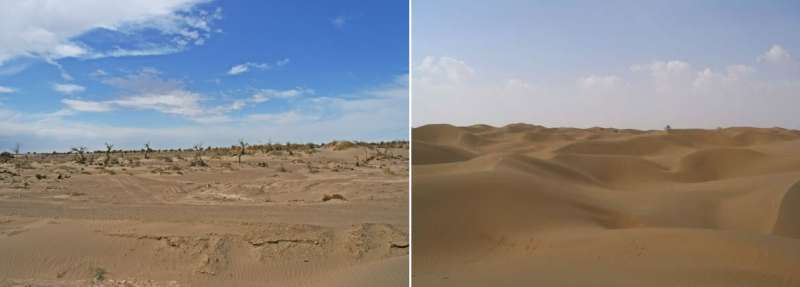What is the cause of dust concentrations over East Asia?

Dust, one of the major aerosol constituents of the global aerosol burden, is an active component in Earth's physical, chemical and biogeochemical cycles. In addition, dust aerosols induce adverse effects on social and economic development. A case study for the dust storm in Beijing indicated total economic loss due to dust storms ranging from 2,268.5 million RMB (US$273.3 million) to 5,796 million RMB (US$698.3 million). Increased concentrations of particulate matter in the atmosphere during dust storms can also lead to acute respiratory damage and long-term sickness such as desert pneumoconiosis.
Located in the central Tarim Basin (Figure 1a), the Taklimakan Desert (TD) covers an area of approximately 337,600 km2, making it the largest desert in China and the second-largest drifting desert in the world. The TD has long been regarded as the major source of dust concentrations over East Asia. Nevertheless, researchers have underestimated the importance of the Gobi Desert (GD) contribution to East Asian dust concentrations, and there is still a great gap in related studies. There are large uncertainties in the quantification of the contributions of the TD and GD dust to the total dust concentrations over East Asia.
A new study titled "Comparison of dust emissions, transport, and deposition between the Taklimakan Desert and Gobi Desert from 2007 to 2011" has been published in SCIENCE CHINA Earth Sciences. This research was conducted by Jianping Huang research group at Lanzhou University in China (the first author Siyu Chen is the team member). They compared quantitative differences in dust emissions, transport and wet/dry deposition over the TD and the GD in different seasons from 2007 to 2011 based on the WRF-Chem model and satellite retrievals. The authors also comprehensively analyzed the reasons for these differences.
The research found that dust emissions, uplift and long-range transport related to these two dust source regions were markedly different due to divergences in topography, elevation, thermal conditions and atmospheric circulation. Although the TD is of the greatest dust emission capacity over East Asia, the GD is the major contributor to East Asian dust concentrations rather than the TD. To be more specific, the TD is located in the Tarim Basin and surrounded by mountains on three sides. Furthermore, the dominant surface wind direction is eastward and the average wind speed at high altitudes is relatively small over the TD. As a result, the TD dust particles are not easily transported outside the Tarim Basin, such that most of the dust particles are re-deposited after uplift, at a total deposition rate of about 40 g m-2. It is only when the TD dust particles are uplifted above 4 km and entrained in westerlies that they undergo long-range transport.
Compared with the TD, the topography of the GD is relatively flat and at a high elevation, and the area is under the influence of two jet streams at high altitudes, resulting in high wind speeds in the upper atmosphere. Deep convective mixing enables the descending branch of the jet streams to continuously transport momentum downward to the mid-troposphere, leading to enhanced wind speeds in the lower troposphere over the GD, which favors the vertical uplift of the GD dust particles. Therefore, the GD dust was very likely to be transported under the effect of strong westerly jets, and thus played the most important role in contributing to dust concentrations in East Asia. Approximately 35 percent and 31 percent of dust emitted from the GD transported to remote areas in East Asia in spring and summer, respectively.
The research provides a new perspective based on previous work. It emphasizes that the GD dust contributes greatly to dust concentrations and the related climate effect induced by dust over East Asia. These studies also argue for desertification control in the GD regions.
More information: SiYu Chen et al, Comparison of dust emissions, transport, and deposition between the Taklimakan Desert and Gobi Desert from 2007 to 2011, Science China Earth Sciences (2017). DOI: 10.1007/s11430-016-9051-0
Journal information: Science China Earth Sciences
Provided by Science China Press


















